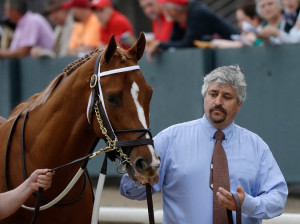PETA Accuses Two Trainers of Cruelty to Horses
ANIMAL RIGHTS - VEGETARIANISM, 24 Mar 2014
Joe Drape – International New York Times
Over a 26-year career, the trainer Steve Asmussen has built one of horse racing’s largest and most successful operations. He ranks second in career victories, with more than 6,700; has earned more than $214 million in purses, the fifth most in thoroughbred racing; and was recently included on the National Museum of Racing’s Hall of Fame ballot.

The trainer Steve Asmussen ranks second in career victories, with more than 6,700.
Credit Danny Johnston/Associated Press
But People for the Ethical Treatment of Animals, after conducting an undercover investigation, has accused Asmussen and his top assistant trainer, Scott Blasi, of subjecting their horses to cruel and injurious treatments, administering drugs to them for nontherapeutic purposes, and having one of their jockeys use an electrical device to shock horses into running faster. As a result of its findings, PETA filed complaints with federal and state agencies in Kentucky and New York on Tuesday [18 Mar 2014], saying Asmussen “forced injured and/or suffering horses to race and train.”
The undercover inquiry was conducted by a PETA investigator who worked for Asmussen for four months in the spring and summer of 2013 at Churchill Downs in Louisville, Ky., and Saratoga Race Course in Saratoga Springs, N.Y.

Nehro, center, the 2011 Derby runner-up, died last year. PETA recorded discussions of his foot problems. Credit Rob Carr/Getty Images
The investigator used a hidden camera to record more than seven hours of video that showed mistreatment of the horses to be widespread and cavalier. In addition, PETA produced a 285-page report about Asmussen’s operations that consisted of the investigator’s notes, medical documents and reports from veterinarians who reviewed the videotape.
“It is certainly a surprise to Mr. Asmussen and Mr. Blasi that anyone would deceptively get a job and keep surveillance and their notes on their conduct for the agenda of others,” Clark Brewster, a lawyer for the two men, said Wednesday. “They will reserve comment with regard to any accusations until they have had the opportunity to fully review them. Then they will respond factually.”
The New York Times reviewed the video and documents, along with the legal complaints, and interviewed the investigator and others involved in the operation, but played no role in the investigation. PETA shared the material on the condition that The Times not publish the investigator’s name.
Video clips and the report depicted the Asmussen barn and the backsides of two of the United States’ most storied racetracks as places where horses were treated as commodities and given numerous joint injections as well as tranquilizers, painkillers and supplements.
Over the past 30 years, PETA has aggressively assailed corporations for the way they treat animals and has run undercover investigations. But the Asmussen investigation was PETA’s first significant step into advocacy in the horse racing world. The organization said the treatment of racehorses would become a priority for the group.
“We wanted to know exactly what happens to thoroughbreds in a top racing stable,” Kathy Guillermo, the senior vice president for PETA, said. “It was devastating to see sore, exhausted, drugged horses every single day. Some were in so much pain it hurt them even to stand, yet they were trained and run anyway.”
PETA has also accused Asmussen of employing undocumented workers, requiring them to use false names on Internal Revenue Service forms, and conspiring with Blasi to produce false identification documents, according to the complaints filed with state and federal agencies. Asmussen also paid the PETA investigator $5.95 an hour — less than minimum wage — and did not pay proper overtime wages, according to complaints filed with the labor departments of Kentucky and New York.
Blasi was recorded discussing injured horses, as well as how one of his jockeys, Ricardo Santana Jr., 21, used a buzzer to shock horses, a practice that is banned in racing.
Santana’s agent, Ruben Muñoz, said the rider had never used an electrical device. “He’s a good, hardworking kid,” Muñoz said of Santana. “I’d put my neck out that he has no part of this.”
The allegations come as horse racing continues to wrestle publicly with a drug culture that its officials concede has badly damaged the sport. A New York Times investigation in 2012 showed how a pervasive drug culture, encouraged by trainers and aided by veterinarians, put horses and riders at risk. The Times found that 24 horses a week died at American tracks, a rate greater than in countries where drug use was severely restricted.
Congress has held multiple hearings and proposed legislation that would create stricter rules and give the United States Anti-Doping Agency authority to enforce them.
Asmussen, who has a current Kentucky Derby contender in Tapiture, has run afoul of regulators before. In 2006, he served a six-month suspension after a filly he trained tested 750 times over the legal limit in Louisiana for the local anesthetic mepivacaine, which can deaden pain in a horse’s legs. Instead of losing his livelihood, Asmussen turned his horses over to Blasi, who won another 198 races as the stable finished the year with more than $14 million in earnings.
On the tapes, Blasi was a profane narrator to the murky goings-on at American racetracks and was often heard bemoaning the lame horses in his barn. At Churchill Downs, in the days before the Debutante Stakes last June, Blasi was frustrated that the 2-year-old filly Teardrop appeared to be injured.
“There’s always something wrong with ‘em,” he said at the end of a profanity-laced lament.
Four days later, however, Teardrop ran in the $100,000 Debutante, finishing seventh as the second favorite at odds of 8 to 5.
Blasi also discussed in detail the chronic foot problems of Nehro, the 2011 Kentucky Derby runner-up, shedding light on why the son of Mineshaft never lived up to the potential he flashed at Churchill Downs that day. Nehro had hole-ridden hooves that were held together with filler and even strong glue, according to the investigation.
On April 17, 2013, only four days after Nehro finished fifth in an Arkansas race, Blasi and his blacksmith, along with other members of the Asmussen staff, discussed the horse’s tender feet and their efforts to keep them on the racetrack. In the video, the blacksmith pointed to Nehro’s right leg and said that it did not have a pulse and that one barely registered in his left.
The horse was clearly uncomfortable as they poked at what they described as “a hole right through that sore right there.”
“His foot is a little bitty nub,” said the blacksmith, who was identified as “Dave” in the investigation.
On the recording, Blasi acknowledged how much Nehro hurt. Still, the horse continued to train. On the morning of last year’s Kentucky Derby, Nehro got sick on the backside of Churchill Downs. Asmussen later said that the horse died from colic in a van on the way to the hospital.
In a separate conversation, recorded on Aug. 13, Blasi described Santana as a good “machine rider,” referring to an electrical device to shock horses into running faster.
Blasi recounted a conversation he said he had with Santana. “You got the máquina?” Blasi said he asked, referring to the Spanish word for machine. “Boss, I got the máquina,” was Santana’s reply, according to Blasi.
The video and the report show how multiple drugs are given daily to racehorses — whether they need them or not — by grooms and employees so they can pass veterinarians’ visual inspections, make it to the racetrack or perform at a higher level.
At another point in the video, Dr. James Hunt Jr., a prominent New York veterinarian, was shown giving a horse furosemide, a diuretic sold as Lasix that helps prevent exercise-induced pulmonary bleeding. The drug’s long-term effects have been a matter of public debate. It is prohibited in most countries but is legal in the United States despite widespread efforts to ban it.
Hunt acknowledged to the investigator that many horses who received furosemide did not need it. He did not respond to several messages seeking comment.
“It’s a performance-enhancer,” he said in a conversation recorded on camera. “It makes them lighter.”
_______________________
Joe Drape is an award-winning sportswriter for The New York Times.
A version of this article appears in print on March 20, 2014, on page B13 of the New York edition with the headline: PETA Accuses 2 Trainers of Cruelty to Horses.
DISCLAIMER: The statements, views and opinions expressed in pieces republished here are solely those of the authors and do not necessarily represent those of TMS. In accordance with title 17 U.S.C. section 107, this material is distributed without profit to those who have expressed a prior interest in receiving the included information for research and educational purposes. TMS has no affiliation whatsoever with the originator of this article nor is TMS endorsed or sponsored by the originator. “GO TO ORIGINAL” links are provided as a convenience to our readers and allow for verification of authenticity. However, as originating pages are often updated by their originating host sites, the versions posted may not match the versions our readers view when clicking the “GO TO ORIGINAL” links. This site contains copyrighted material the use of which has not always been specifically authorized by the copyright owner. We are making such material available in our efforts to advance understanding of environmental, political, human rights, economic, democracy, scientific, and social justice issues, etc. We believe this constitutes a ‘fair use’ of any such copyrighted material as provided for in section 107 of the US Copyright Law. In accordance with Title 17 U.S.C. Section 107, the material on this site is distributed without profit to those who have expressed a prior interest in receiving the included information for research and educational purposes. For more information go to: http://www.law.cornell.edu/uscode/17/107.shtml. If you wish to use copyrighted material from this site for purposes of your own that go beyond ‘fair use’, you must obtain permission from the copyright owner.
Read more
Click here to go to the current weekly digest or pick another article:
ANIMAL RIGHTS - VEGETARIANISM: